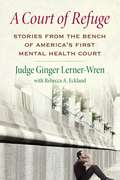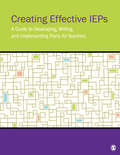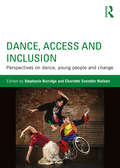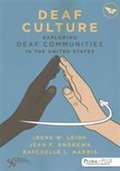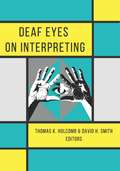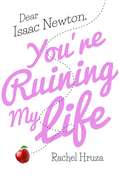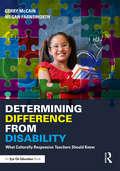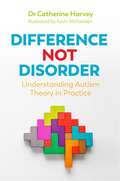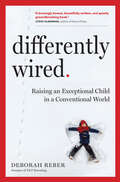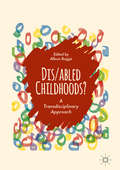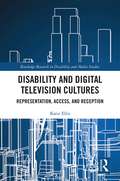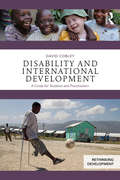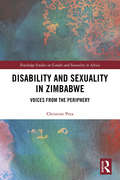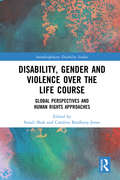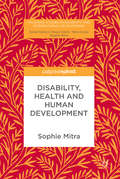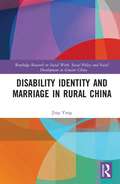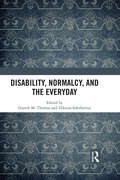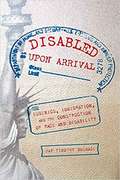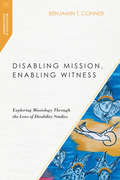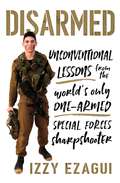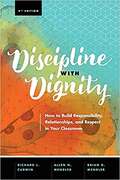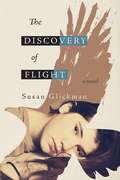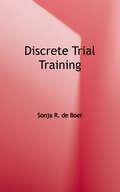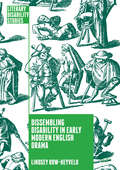- Table View
- List View
A Court of Refuge: Stories from the Bench of America's First Mental Health Court
by Ginger Lerner-Wren Rebecca A. EcklandThe story of America's first Mental Health Court as told by its presiding judge, Judge Ginger Lerner-Wren--from its inception in 1997 to its implementation in over 400 courts across the nationAs a young legal advocate, Ginger Lerner-Wren bore witness to the consequences of an underdeveloped mental health care infrastructure. Unable to do more than offer guidance, she watched families being torn apart as client after client was ensnared in the criminal system for crimes committed as a result of addiction, homelessness, and mental illness. She soon learned this was a far-reaching crisis--estimates show that in forty-four states, jails and prisons house ten times more people with serious mental illnesses than state psychiatric hospitals. In A Court of Refuge, Judge Ginger Lerner-Wren tells the story of how the first dedicated mental health court in the United States grew from an offshoot of her criminal division, held during lunch hour without the aid of any federal funding, to a revolutionary institution. Of the two hundred thousand people behind bars at the court's inception in 1997, more than one in ten were known to have schizophrenia, bipolar disorder, or major depression. To date, the court has successfully diverted more than twenty thousand people suffering from various psychiatric conditions from jail and into treatment facilities and other community resources. Working under the theoretical framework of therapeutic jurisprudence, Judge Lerner-Wren and her growing network of fierce, determined advocates, families, and supporters sparked a national movement to conceptualize courts as a place of healing. Today, there are hundreds of such courts in the US.Poignant and compassionately written, A Court of Refuge demonstrates both the potential relief mental health courts can provide to underserved communities and their limitations in a system in dire need of vast overhauls of the policies that got us here. Lerner-Wren presents a refreshing possibility for a future in which criminal justice and mental health care can work in tandem to address this vexing human rights issue--and to change our attitudes about mental illness as a whole.
Creating Effective IEPs: A Guide to Developing, Writing, and Implementing Plans for Teachers
by Nancy BurtonCreating Effective IEPs: A Guide to Developing, Writing, and Implementing Plans for Teachers is a brief primer on Individualized Education Plans that has been developed as a custom supplement for textbooks in Introduction to Education, Introduction to Inclusion, and SPED Teaching Strategies. The Individualized Education Plan is one of the most important parts of an exceptional child’s education – it is the document shared among teachers, administrators, paraprofessionals and parents that outlines the accommodations and strategies for educating a child with special needs. An effective IEP must be well-thought out, clearly defined, and embraced by all parties involved in a child’s education, including administrators and parents. This primer provides practical instruction for writing IEPs, leading IEP meetings, and implementing the goals in a classroom setting. Practical exercises and real-world appendices help make the material accessible for students preparing to enter the workforce.
Creating Effective IEPs: A Guide to Developing, Writing, and Implementing Plans for Teachers
by Nancy BurtonCreating Effective IEPs: A Guide to Developing, Writing, and Implementing Plans for Teachers is a brief primer on Individualized Education Plans that has been developed as a custom supplement for textbooks in Introduction to Education, Introduction to Inclusion, and SPED Teaching Strategies. The Individualized Education Plan is one of the most important parts of an exceptional child’s education – it is the document shared among teachers, administrators, paraprofessionals and parents that outlines the accommodations and strategies for educating a child with special needs. An effective IEP must be well-thought out, clearly defined, and embraced by all parties involved in a child’s education, including administrators and parents. This primer provides practical instruction for writing IEPs, leading IEP meetings, and implementing the goals in a classroom setting. Practical exercises and real-world appendices help make the material accessible for students preparing to enter the workforce.
Dance, Access and Inclusion: Perspectives on Dance, Young People and Change
by Charlotte Svendler Nielsen Stephanie BurridgeThe arts have a crucial role in empowering young people with special needs through diverse dance initiatives. Inclusive pedagogy that integrates all students in rich, equitable and just dance programmes within education frameworks is occurring alongside enabling projects by community groups and in the professional dance world where many high-profile choreographers actively seek opportunities to work across diversity to inspire creativity. Access and inclusion is increasingly the essence of projects for disenfranchised and traumatised youth who find creative expression, freedom and hope through dance. This volume foregrounds dance for young people with special needs and presents best practice scenarios in schools, communities and the professional sphere. International perspectives come from Australia, Brazil, Cambodia, Canada, Denmark, Fiji, Finland, India, Indonesia, Jamaica, Japan, Malaysia, New Zealand, Norway, Papua New Guinea, Portugal, Singapore, South Africa, Spain, Taiwan, Timor Leste, the UK and the USA. Sections include: inclusive dance pedagogy equality, advocacy and policy changing practice for dance education community dance initiatives professional integrated collaborations
Deaf Culture: Exploring Deaf Communities in the United States
by Raychelle L. Harris Irene W. Leigh Jean F. AndrewsHow does Deaf culture fit into education, psychology, cultural studies, technology and the arts? Deaf Culture: Exploring Deaf Communities in the United States addresses this through both theoretical and practical information. With the recognition of American Sign Language (ASL) as a bona fide language, the perception of Deaf people has evolved into the recognition of a vibrant Deaf culture centered around the use of signed languages and communities of Deaf people. This text also describes how rapid advances in technology, including the Internet as well as new visual and auditory technologies, have not only created opportunities for Deaf people to influence how technology can be used, but additionally has become a powerful force in influencing the behavior of Deaf individuals within diverse national and international societies. This has created opportunities for incorporating diversity and international perspectives into Deaf culture. Within each chapter are multiple vignettes, examples, pictures, and stories to enhance content interest for readers and facilitate instructor teaching. Theories are introduced and explained in a practical and reader-friendly manner to ensure understanding, and clear examples are provided to illustrate concepts. In addition, students of American Sign Language and Deaf Studies will find an introduction to possible opportunities for professional and informal involvement with ASL/Deaf culture children and adults. Deaf Culture fills a unique niche as an introductory text that is accessible and straightforward for those beginning their studies of the Deaf-World.
Deaf Eyes on Interpreting
by Thomas K. Holcomb David H. SmithAs the ASL-English interpreting field has become professionalized, there is a growing disconnect between interpreters and the Deaf consumers they serve. Whereas interpreting used to be a community-based practice, the field is growing into a research-based profession that begins in a classroom rather than in the Deaf community. Despite the many gains being made in the interpreting services profession, with an emphasis on the accuracy of the interpreted work, the perspectives of Deaf individuals are rarely documented in the literature. Opportunities for enhanced participation and full inclusion need to be considered in order for Deaf people to best represent themselves to the hearing, nonsigning public as competent and intelligent individuals. Deaf Eyes on Interpreting brings Deaf people to the forefront of the discussions about what constitutes quality interpreting services. The contributors are all Deaf professionals who use interpreters on a regular basis, and their insights and recommendations are based on research as well as on personal experiences. These multiple perspectives reveal strategies to maximize access to interpreted work and hearing environments and to facilitate trust and understanding between interpreters and Deaf consumers. Interpreter educators, interpreting students, professional interpreters, and Deaf individuals will all benefit from the approaches offered in this collection.
Dear Isaac Newton, You're Ruining My Life
by Rachel HruzaAs if seventh grade isn't hard enough, Truth Trendon learns she has to wear a back brace to help her worsening scoliosis. She decides gravity is to blame for curving her spine and ruining her life. Thanks for nothing, Isaac Newton!Truth's brace is hard plastic, tight, and uncomfortable. She has to wear a t-shirt under it and bulky clothes over it, making her feel both sweaty and unfashionable. She's terrified that her classmates are going to find out about it. But it's hard keeping it a secret (especially when gym class is involved), and secrets quickly turn into lies. When Truth's crush entrusts her with a big secret of his own, it leads to even more lying. Add to that a fight with her best friend, a looming school-wide presentation, and mean rumors, and it's a recipe for disaster. As Truth navigates the ups and downs of middle school, can she learn to accept her true self, curvy spine and all?
Determining Difference from Disability: What Culturally Responsive Teachers Should Know
by Gerry McCain Megan FarnsworthThis essential book offers clear guidelines for determining if the Culturally Linguistically Diverse (CLD) students / English Language Learners (ELL) in your general education classroom are experiencing typical language differences, learning disabilities, or both. By combining helpful case-studies with insightful research, the authors provide a framework for differentiating instruction that uses culturally appropriate interventions to build upon student strengths while creating a foundation for further learning and achievement. You will discover how to: Connect your own and your students’ cultural assets to classroom content; Review language acquisition stages and design corresponding instruction; Collaborate with peers and discuss the realities of reaching out for support and problem solving; Choose effective and appropriate instructional strategies based on documentation of data through progress monitoring; Move from a traditional behavioristic perspective to a more culturally responsive perspective; Identify patterns in formal assessments and informal instruction in order to distinguish between language differences and learning disabilities. In addition, the book includes a number of activities and graphs that can be implemented immediately in any classroom. Many of these materials can be downloaded for free from the book’s product page: www.routledge.com/9781138577756.
Difference Not Disorder: Understanding Autism Theory in Practice
by Dr Catherine Harvey Kevin McFaddenInterventions and educational approaches for children with autism spectrum disorders have developed in response to the different models for how autism has been constructed and understood. This book explores the evolving theories on autism and how these have impacted the interventions and outcomes in education. Drawing on 30 years of professional experience and detailed research, Harvey exposes the myths around autism, advocates for understanding autism as difference rather than impairment, and provides practical guidance on teaching and learning, behaviour management, addressing sensory and physical needs of children with ASD. This accessible overview shows how to put autism research into practice, learn from historic mistakes and create the most supportive environment for children on the autism spectrum.
Differently Wired: Raising an Exceptional Child in a Conventional World
by Deborah ReberToday millions of kids are stuck in a world that doesn't respect, support, or embrace who they really are—these are what Deborah Reber is calling the “differently wired” kids, the one in five children with ADHD, dyslexia, Asperger’s, giftedness, anxiety, sensory processing disorder, and other neurodifferences. Their challenges are many. But for the parents who love them, the challenges are just as hard—struggling to find the right school, the right therapist, the right parenting group while feeling isolated and harboring endless internal doubts about what’s normal, what’s not, and how to handle it all. But now there’s hope. Written by Deborah Reber, a bestselling author and mother in the midst of an eye-opening journey with her son who is twice exceptional (he has ADHD, Asperger’s, and is highly gifted), Differently Wired is a how-to, a manifesto, a book of wise advice, and the best kind of been-there, done-that companion. On the one hand it’s a book of saying NO, and how it’s time to say no to trying to fit your round-peg kid into society’s square holes, no to educational and social systems that don’t respect your child, no to the anxiety and fear that keep parents stuck. And then it’s a book of YES. By offering 18 paradigm shifts—what she calls “tilts”— Reber shows how to change everything. How to “Get Out of Isolation and Connect.” “Stop Fighting Who Your Child Is and Lean In.” “Let Go of What Others Think.” “Create a World Where Your Child Can Feel Secure.” “Find Your People (and Ditch the Rest).” “Help Your Kids Embrace Self-Discovery.” And through these alternative ways of being, discover how to stay open, pay attention, and become an exceptional parent to your exceptional child.
Dis/abled Childhoods?
by Allison BoggisThis edited collection explores the intersectionality of childhood and disability. Whereas available scholarship tends to concentrate on care-giving, parenting, or supporting and teaching children and young people with special educational needs and disabilities, the contributors to this collection offer an engaging and accessible insight into childhoods that are impacted by disability and impairment. The discussions cut across traditional disciplinary divides and offer critical insights into the key issues that relate to disabled children and young people's lives, encouraging the exploration of both disability and childhoods in their broadest terms. Dis/abled Childhoods? will be of interest to students and scholars across a range of disciplines including Special Educational Needs; Childhood Studies; Disability Studies; Youth Studies; and Health and Social Care.
Disability and Digital Television Cultures: Representation, Access, and Reception (Routledge Research in Disability and Media Studies)
by Katie EllisDisability and Digital Television Cultures offers an important addition to scholarly studies at the intersection of disability and media, examining disability in the context of digital television access, representation and reception. Television, as a central medium of communication, has marginalized people with disability through both representation on screen and the lack of accessibility to this medium. With accessibility options becoming available as television is switched to digital transmissions, audience research into television representations must include a corresponding consideration of access. This book provides a comprehensive and critical study of the way people with disability access and watch digital TV. International case studies and media reports are complimented by findings of a user-focused study into accessibility and representation captured during the Australian digital television switchover in 2013-2014. This book will provide a reliable, independent guide to fundamental shifts in media access while also offering insight from the disability community. It will be essential reading for researchers working on disability and media, as well as television, communications and culture; upper-level undergraduate and postgraduate students in cultural studies; along with general readers with an interest in disability and digital culture.
Disability and International Development: A Guide for Students and Practitioners (Rethinking Development)
by David CobleyDespite growing evidence of a close and complex relationship between disability and poverty, development policy, planning and programming has often failed to take full account of the concerns of disabled people. However, following the 2006 UN Convention on the Rights of Persons with Disabilities and the post-2015 sustainable development agenda, which promises to ‘leave no one behind’, there have been increasing calls from governments and development agencies for disability to be mainstreamed into all development planning. Disability and International Development provides a comprehensive overview of key themes in the field of disability and development, including issues around identity, poverty, disability rights, education, health, livelihoods, disaster recovery and approaches to researching disability. The book engages with relevant theory and draws on existing literature in the field, as well as the author’s own research and teaching experience, to explore key issues using a range of examples taken from around the world. Written in an accessible and engaging style to suit both students and practitioners, the book also includes a wide range of reflection exercises, discussion questions and further reading suggestions, making it the perfect introduction to disability and international development.
Disability and Sexuality in Zimbabwe: Voices from the Periphery (Routledge Studies on Gender and Sexuality in Africa)
by Christine PetaDisabled women represent one of the most marginalised minority groups in the world, hence they are largely silent while their sexuality is ignored, suppressed, forbidden and buried underneath the carpet. Until recently, most of the Global Northern published literature on the subject of the sexuality of disabled women has predominantly been constructed from hearsay and second-hand narratives in studies which draw from the perspectives of parents, service providers and advocates, without much consultation of the relevant women. By facilitating the voice of disabled women in Zimbabwe and illuminating their experiences of sexuality, this book hopes to shift the experiences of sexuality of disabled women from the periphery of society to the fore. Disability and Sexuality in Zimbabwe presents original research on an issue that is thus far not found in local research data. Whilst addressing the paucity of literature on the subject, the book informs policy and practice and enhances the existing body of knowledge by making recommendations towards the development of a disability and sexuality framework that is rooted in the African context. This book is of interest to students and scholars of African studies, disability studies, sociology, psychology, social work, nursing, education studies, geography, women’s and gender studies and interdisciplinary studies. Additional audiences include a wide range of health, social care, and educational professionals and practitioners, as well donors, disabled people’s organisations, charities, government departments, NGOs, supranational organisations, and policy makers
Disability, Gender and Violence over the Life Course: Global Perspectives and Human Rights Approaches (Interdisciplinary Disability Studies)
by Sonali Shah Caroline Bradbury-JonesThis is the first book to explore the interplay of disability, gender and violence over the life course from researcher, practitioner and survivor perspectives. It gives due weight to the accounts of disabled children and adults who have survived institutional or individual violence, evidencing barriers to recognition, disclosure and reporting. Written by disabled and non-disabled women from around the world, Disability, Gender and Violence over the Life Course addresses the dearth of voices and experiences of disabled women and girls in empirical research, policy and practice on issues of violence, victimisation, protection, support and prevention. Divided into three parts – Childhood, Adulthood and Older Life – this collection offers diverse perspectives on the intersectionality of disability, age, ethnicity, sexuality and violence that have hitherto been absent. This book will be an invaluable resource for students and practitioners of multiple fields of practice and academic studies, including health and social care, nursing, social work, childhood studies, gender studies, disability studies, safeguarding and child protection, equality and human rights, sociology and criminology.
Disability, Health and Human Development (Palgrave Studies in Disability and International Development)
by Sophie MitraThis book introduces the human development model to define disability and map its links with health and well-being, based on Sen’s capability approach. The author uses panel survey data with internationally comparable questions on disability for Ethiopia, Malawi, Tanzania and Uganda. It presents evidence on the prevalence of disability and its strong and consistent association with multidimensional poverty, mortality, economic insecurity and deprivations in education, morbidity and employment. It shows that disability needs to be considered from multiple angles including aging, gender, health and poverty. Ultimately, this study makes a call for inclusion and prevention interventions as solutions to the deprivations associated with impairments and health conditions.
Disability Identity and Marriage in Rural China (Routledge Research on Social Work, Social Policy and Social Development in Greater China)
by Jing YangBased on data collected through in-depth fieldwork observation and interviews in Bai Township, this book examines how women with disabilities in rural Southwest China compensate for their disability identity through marriage. As the first book to theorize the married life of rural-based women with different types of disabilities, it provides a more holistic picture of their marital life by tracing the marriage process from mate selection to wedding ceremony, reproduction and role performance. It also generates a substantive theory grounded in the real experiences of women living with disabilities with Jing Yang arguing that these women are not passive victims in the marital process, but active agents who endeavour to minimize the risk of abuse and maximize security and satisfaction in their marriage. By examining the effects of fertility, patriarchy and village society on women with disability, this book will be of huge interest to students and scholars of many disciplines, including disability studies, sociology, social work, women's studies and Chinese culture and society.
Disability, Normalcy, and the Everyday
by Dikaios Sakellariou Gareth M. ThomasMany critical analyses of disability address important ‘macro’ concerns, but are often far removed from an interactional and micro-level focus. Written by leading scholars in the field, and containing a range of theoretical and empirical contributions from around the world, this book focuses on the taken-for-granted, mundane human activities at the heart of how social life is reproduced, and how this impacts on the lives of those with a disability, family members, and other allies. It departs from earlier accounts by making sense of how disability is lived, mobilised, and enacted in everyday lives. Although broad in focus and navigating diverse social contexts, chapters are united by a concern with foregrounding micro, mundane moments for making sense of powerful discourses, practices, affects, relations, and world-making for disabled people and their allies. Using different examples – including learning disabilities, cerebral palsy, dementia, polio, and Parkinson’s disease – contributions move beyond a simplified narrow classification of disability which creates rigid categories of existence and denies bodily variation. Disability, Normalcy, and the Everyday should be considered essential reading for disability studies students and academics, as well as professionals involved in health and social care. With contributions located within new and familiar debates around embodiment, stigma, gender, identity, inequality, care, ethics, choice, materiality, youth, and representation, this book will be of interest to academics from different disciplinary backgrounds including sociology, anthropology, humanities, public health, allied health professions, science and technology studies, social work, and social policy.
Disabled Upon Arrival: Eugenics, Immigration, And The Construction Of Race And Disability
by Jay Timothy DolmageIn North America, immigration has never been about immigration. That was true in the early twentieth century when anti-immigrant rhetoric led to draconian crackdowns on the movement of bodies, and it is true today as new measures seek to construct migrants as dangerous and undesirable. This premise forms the crux of Jay Timothy Dolmage’s new book Disabled Upon Arrival: Eugenics, Immigration, and the Construction of Race and Disability, a compelling examination of the spaces, technologies, and discourses of immigration restriction during the peak period of North American immigration in the early twentieth century. Through careful archival research and consideration of the larger ideologies of racialization and xenophobia, Disabled Upon Arrival links anti-immigration rhetoric to eugenics—the flawed “science” of controlling human population based on racist and ableist ideas about bodily values. Dolmage casts an enlightening perspective on immigration restriction, showing how eugenic ideas about the value of bodies have never really gone away and revealing how such ideas and attitudes continue to cast groups and individuals as disabled upon arrival.
Disabling Mission Enabling Witness: Exploring Missiology Through the Lens of Disability Studies (Missiological Engagements)
by Benjamin T. ConnerHow would it look if we "disabled" Christian theology, discipleship, and theological education? Benjamin Conner initiates a new conversation between disability studies and Christian theology and missiology, imagining a church that fully incorporates persons with disabilities into its mission. In this vision, people with disabilities are part of the church's pluriform witness, and the congregation embodies a robust hermeneutic of the gospel.
Disarmed: Unconventional Lessons from the World's Only One-Armed Special Forces Sharpshooter
by Izzy EzaguiThe inspiring story of a young American who volunteered to fight in the Israel Defense Forces, lost his arm in combat, and then returned to the battlefield.Combining refreshing candor with self-deprecating wit, this inspiring memoir will encourage readers to live up to their aspirations despite seemingly impossible odds.On January 8, 2009, Izzy Ezagui--an American who had enlisted in the Israel Defense Forces (IDF) at nineteen--lost his arm in a mortar attack on the border of the Gaza Strip. In this stirring and wryly humorous memoir, Izzy recounts his tortuous trek through rehabilitation to re-enlistment as a squad commander in the IDF. He became the world's only one-armed Special Forces sharpshooter.This isn't a typical war chronicle, full of macho bluster and the usual hero tropes. Izzy wrote this book with his fellow millennials in mind--not necessarily those with military ambitions, but everyone facing life's daily battles. His message is universal: if a self-described "nerd" and "one-armed basket case" like him can accomplish what he set his mind to, then anyone can become a hero in his or her own life.Growing up in a religious household in Miami, Izzy's early life was plagued by self-doubt, family drama, and (far too few) girl troubles. His search for direction eventually led him to that explosion on the Gaza border, changing his life forever.In the midst of disaster, Izzy discovered a deep well at his core, from which he could draw strength. Through his motivational speeches across the world, and now through this book, he encourages people to seek their own power, and to face whatever adversity life throws at them.
Discipline With Dignity, 4th Edition: How To Build Responsibility, Relationships, And Respect In Your Classroom
by Richard L. Curwin Allen N. Mendler Brian D. MendlerIn this revised and updated 4th edition, Discipline with Dignity provides in-depth guidance for implementing a proven approach to classroom management that can help students make better choices and teachers be more effective. Emphasizing the importance of mutual respect and self-control, the authors offer specific strategies and techniques for building strong relationships with disruptive students and countering the toxic social circumstances that affect many of them, including dysfunctional families, gangs, and poverty. Educators at all levels can learn The difference between formal and informal discipline systems and when to use each. The role of values, rules, and consequences. How to address the underlying causes of discipline problems that occur both in and out of school. What teachers can do to defuse or prevent classroom disruptions and disrespectful behavior without removing students from the classroom. Why traditional approaches such as threats, punishments, and rewards are ineffective—and what to do instead. How to use relevance, teacher enthusiasm, choice, and other elements of curriculum and instruction to motivate students. How to reduce both teacher and student stress that can trigger power struggles. With dozens of specific examples of student-teacher interactions, Discipline with Dignity illustrates what you can do—and not do—to make the classroom a place where students learn and teachers maintain control in a nonconfrontational way. The goal is success for all, in schools that thrive.
The Discovery of Flight (13c. Teen Gold( Cats Parade) #851)
by Susan GlickmanTwo threads comprise this young-adult novel, originally published in Canada. One is a journal that spans one school year in the life of twelve-year-old Sophie, and the other is the novel her sister, Libby is writing for her as a birthday surprise. Libby, who has cerebral palsy, communicates through the use of a computer. Sophie writes about school, friendship, preparing for her Bat Mitzvah, and her sister's deteriorating health. Libby's novel is a fantasy about the relationship between a girl and a hawk.
Discrete Trial Training
by Sonja R. DeBoerDiscrete trial training (DTT) is a method of teaching individuals with autism spectrum disorder (ASD) based on applied behavior analysis (ABA). Skills are broken into discrete steps and then taught in massed trials. With DTT, steps are taught one at a time, instead of teaching an entire skill all at once. Concepts covered include errorless learning, methods of reinforcement, and how to use behavior momentum. The text explains how to collect, interpret, and use data to make teaching decisions. Finally, the text details a method for evaluating implementation of DTT.
Dissembling Disability in Early Modern English Drama (Literary Disability Studies)
by Lindsey Row-HeyveldWhy do able-bodied characters fake disability in 40 early modern English plays? This book uncovers a previously unexamined theatrical tradition and explores the way counterfeit disability captivated the Renaissance stage. Through detailed case studies of both lesser-known and canonical plays (by Shakespeare, Jonson, Marston, and others), Lindsey Row-Heyveld demonstrates why counterfeit disability proved so useful to early modern playwrights. Changing approaches to almsgiving in the English Reformation led to increasing concerns about feigned disability. The theater capitalized on those concerns, using the counterfeit-disability tradition to explore issues of charity, epistemology, and spectatorship. By illuminating this neglected tradition, this book fills an important gap in both disability history and literary studies, and explores how fears of counterfeit disability created a feedback loop of performance and suspicion. The result is the still-pervasive insistence that even genuinely disabled people must perform in order to, paradoxically, prove the authenticity of their impairments.
